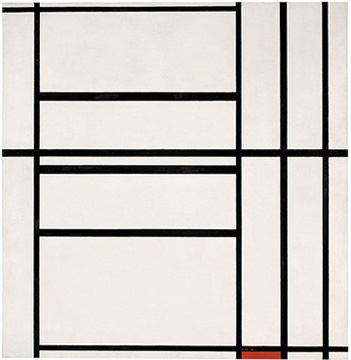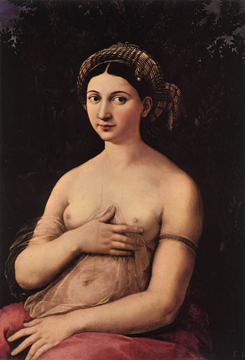
Piet Mondrian, "Composition No. 1 Composition with Red," 1938-39. Oil on canvas mounted on wood support. Courtesy the Peggy Guggenheim Collection.
Select ONE answer for ALL of the below questions:
- Does art expand our ability to imagine?
- What’s Matt Cassel without Randy Moss, Wes Welker and Bill Belichick?
- What came first: the chicken or the egg?
- City or United?
- Sporty Spice
- Sure, why not
- The $63 million man
- The egg
I love this. Truly and seriously, I absolutely love impossible-to-answer questions.
Who’s your favorite artist of all time? I always vote Titian, but I’m going to say Jeff Koons, if only in solidarity with my colleague from London Town.
If you could only take one album to a desert island what would it be? Probably Blue Train, but I almost said the first Wu-Tang album.
Why do I always make groups of three? Catholic school, ZZ Top, a vast Freemason conspiracy.
This is a fortuitous collision of a number of things I’ve been trying to crowbar into a single post for a minute, so I’m pleased that Art21 has made Question #1 this month’s Flash Points topic. I’ve been reading Elliot Kalb’s Who’s Better, Who’s Best in Basketball?, which attempts to use statistics to demonstrate the sequential superiority of the top 50 hoopsters of all time. Think Roger de Piles with a 360 slam-dunk. Fun stuff, but, like much of the academic endeavor, an attempt to fix and quantify the unquantifiable, or the invisible or the undemonstrable, like the definition for “undemonstrable” in the dictionary. But if Krauss gets “Modernist not-ground,” then I get undemonstrable.

Raphael La Fornarina 1518-19 Oil on panel Courtesy the Galleria Nazionale d'Arte Antica, Rome.
This Flash Point is another one of these beautifully impossible questions. Does art expand our ability to imagine? Dunno. Perhaps Dali shows that art helps us depict the already imagined. Perhaps Bosch heard about all of those infernal tortures in a Sunday sermon. Perhaps Raphael had to imagine La Fornarina before he painted her, so the answer is no, it actually goes the other direction.
But what about Dante, who certainly imagined things in ways that had no precedent or source? Or Neoplatonism, which just scrambles things beyond recognition? So…Michelangelo’s David looks the way he does because Michelangelo had to correct the human body, imagine it the way the Divine had intended it? So…it’s based on an unreal prototype that real bodies only partially emulate, until a real artist makes an unreal body out of them? Who’s on first, What’s on second, I Don’t Know is on third…
The one that I love is Mondrian. Not because he’s really high on my list of best artists, but because his work expands our ability to imagine. I read the following argument at some point during grad school, but like much of what I read in grad school, it survives as snippets of ideas or floating theories, universally without citation or any sense of origin.
What I remember reading was that Mondrian’s mature works, with all of their perpendiculars and primaries, might be understood as models for a Utopian society. That their compositional and color harmonies provide what is a visual counterpart for a perfectly constructed balanced society. The way Broadway Boogie-Woogie looks like Manhattan from above? Well, it all looks like society should look ideologically. Mutually supportive, clean, efficient. With the exception of a select group, we all know Utopia is impossible to achieve. But, if we can imagine it, we can strive towards it, perhaps even approximate it. Like Neoplatonism. Keep hope alive, indeed.
So I’m going to go with yes, at least here, with this one gorgeous example. Art expands our ability to imagine by offering visions of what can be, might be, should be. Sure, much of this is based in reality, like La Fornarina. Much of it isn’t, like David or Dante.
Art certainly makes me imagine. But so does food. I guess it doesn’t really matter anyway, Bonnie Dobson would say. You know what I think Moses saw on the mountain top? Nothing. He saw the promise, not the Promised Land. The prophecy, not its fulfillment. That’s why the question is impossible and unnecessary to answer. It doesn’t matter if the art is what makes us imagine, or if what we imagine makes the art happen. It’s like CatDog. It’s a cat and a dog. The answer is probably yes, probably no. The fact that the imagining is happening at all is what matters. And now I’m turning into a Hallmark card. I’m going to go imagine myself doing something else.
By the way, Shaquille O’Neal is Kalb’s #1, followed by Wilt Chamberlain, and Michael Jordan. Clyde Drexler rounds out the list at #50.




Pingback: What’s Cookin at the Art21 Blog: A Weekly Index | Art21 Blog
Pingback: Hoopster Canvas Art